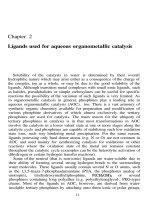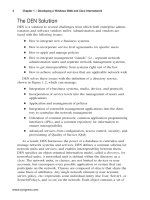Tài liệu 70 Space-Time Adaptive Processing for Airborne Surveillance Radar doc
Bạn đang xem bản rút gọn của tài liệu. Xem và tải ngay bản đầy đủ của tài liệu tại đây (316.49 KB, 16 trang )
Hong Wang. “Space-Time Adaptive Processing for Airborne Surveillance Radar.”
2000 CRC Press LLC. <>.
Space-TimeAdaptiveProcessing
forAirborneSurveillanceRadar
HongWang
SyracuseUniversity
70.1MainReceiveApertureandAnalogBeamforming
70.2DatatobeProcessed
70.3TheProcessingNeedsandMajorIssues
70.4TemporalDOFReduction
70.5AdaptiveFilteringwithNeededandSample-Supportable
DOFandEmbeddedCFARProcessing
70.6Scan-To-ScanTrack-Before-DetectProcessing
70.7Real-TimeNonhomogeneityDetectionandSample
ConditioningandSelection
70.8SpaceorSpace-RangeAdaptivePre-SuppressionofJammers
70.9ASTAPExamplewithaRevisittoAnalogBeamforming
70.10Summary
References
Space-TimeAdaptiveProcessing(STAP)isamulti-dimensionalfilteringtechniquedevelopedfor
minimizingtheeffectsofvariouskindsofinterferenceontargetdetectionwithapulsedairborne
surveillanceradar.Themostcommondimensions,orfilteringdomains,generallyincludetheaz-
imuthangle,elevationangle,polarizationangle,dopplerfrequency,etc.inwhichtherelativelyweak
targetsignaltobedetectedandtheinterferencehavecertaindifferences.Inthefollowing,theSTAP
principlewillbeillustratedforfilteringinthejointazimuthangle(space)anddopplerfrequency
(time)domainonly.
STAPhasbeenaveryactiveresearchanddevelopmentareasincethepublicationofReedetal.’s
seminalpaper[1].WiththerecentlycompletedMultichannelAirborneRadarMeasurementproject
(MCARM)[2]–[5],STAPhasbeenestablishedasavaluablealternativetothetraditionalapproaches,
suchasultra-lowsidelobebeamformingandDisplacedPhaseCenterAntenna(DPCA)[6].Muchof
STAPresearchanddevelopmenteffortshavebeendrivenbytheneedstomakethesystemaffordable,
tosimplifyitsfront-hardwarecalibration,andtominimizethesystem’sperformancelossinseverely
nonhomogeneousenvironments.Figure70.1isageneralconfigurationofSTAPfunctionalblocks[5,
7]whoseprincipleswillbediscussedinthefollowingsections.
c
1999byCRCPressLLC
FIGURE 70.1: A general STAP configuration with auxiliary and main arrays.
70.1 Main Receive Aperture and Analog Beamforming
For conceptual clarity, the STAP configuration of Fig. 70.1 separates a possibly integrated aperture
into two parts: the main aperture which is most likely shared by the radar transmitter, and an
auxiliary array of spatially distributed channels for suppression of Wideband Noise Jammers (WNJ).
For convenience of discussion, the main aperture is assumed to have N
c
columns of elements, with
the column spacing equal to a half wavelength and elements in each column being combined to
produce a pre-designed, nonadaptive elevation beam-pattern.
The size of the main aperture in terms of the system’s chosen wavelength is an important system
parameter, usuallydeterminedbythesystemspecificationsoftherequiredtransmitterpower-aperture
product as well as azimuth resolution. Typical aperture size spans from a few wavelengths for some
short-range radars to over 60 wavelengths for some airborne early warning systems. The analog
beamformingnetworkcombinesthe N
c
columnsofthemainaperturetoproduce N
s
receiverchannels
whose outputs are digitized for further processing. One should note that the earliest STAP approach
presented in [1], i.e., the so-called “element space” approach, is a special case of Fig. 70.1 when
N
s
= N
c
is chosen.
The design of the analog beamformer affects
c
1999 by CRC Press LLC
1. the system’s overall performance (especially in nonhomogeneous environments),
2. implementation cost,
3. channel calibration burden,
4. system reliability, and
5. controllability of the system’s response pattern.
The design principle will be briefly discussed in Section 70.9; and because of the array’s element
error, column-combiner error, and column mutual-coupling effects, it is quite different from what
is available in the adaptive array literature such as [8], where already digitized, perfectly matched
channels are generally assumed.
Finally, it should be pointed out that the main aperture and analog beamforming network in
Fig. 70.1 may also include nonphased-array hardware, such as the common reflector-feed as well as
the hybrid reflector and phased-array feed [9]. Also, subarraying such as [10] is considered as a form
of analog beamforming of Fig. 70.1.
70.2 Data to be Processed
Assume that the radar transmits, at each look angle, a sequence of N
t
uniformly spaced, phase-
coherent RF pulses as shown in Fig. 70.2 for its envelope only. Each of N
s
receivers typically consists of
a front-end amplifier, down-converter, waveform-matched filter, and A/D converter with a sampling
frequency at least equal to the signal bandwidth. Consider the kth sample of radar return over the
N
t
pulse repetition intervals (PRI) from a single receiver, where the index “k” is commonly called
the range index or cell. The total number of range cells, K
0
is approximately equal to the product of
the PRI and signal bandwidth. The coherent processing interval (CPI) is the product of the PRI and
N
t
; and since a fixed PRI can usually be assumed at a given look angle, CPI and N
t
are often used
interchangeably.
FIGURE 70.2: A sequence of N
t
phase-coherent RF pulses (only envelope shown) transmitted at a
given angle. The pulse repetition frequency (PRF) is 1/T.
With N
s
receiver channels, the data at the kth range cell can be expressed by a matrix X
k
, N
s
× N
t
,
for k = 1, 2,...K
0
. The total amount of data visually forms a “cube” shown in Fig. 70.3, which is
the raw data cube to be processed at a given look angle. It is important to note from Fig. 70.3 that
the term “time” is associated with the CPI for any given range cell, i.e., across the multiple PRIs,
while the term “range” is used within a PRI. Therefore, the meaning of the frequency corresponding
to the time is the so-called doppler frequency, describing the rate of the phase-shift progression of a
return component with respect to the initial phase of the phase-coherent pulse train. The doppler
frequency of a return, e.g., from a moving target, depends on the target velocity and direction as well
as the airborne radar’s platform velocity and direction, etc.
c
1999 by CRC Press LLC
FIGURE 70.3: Raw data at a given look angle and the space, time, and range axes.
70.3 The Processing Needs and Major Issues
At a given look angle, the radar is to detect the existence of targets of unknown range and unknown
doppler frequencyin the presenceofvarious interference. In other words,one can view the processing
as a mapping from the data cube to a range-doppler plane with sufficient suppression of unwanted
components in the data. Like any other filtering, the interference suppression relies on the differences
between wanted target components and unwanted interference components in the angle-doppler
domain. Figure 70.4 illustrates the spectral distribution of potential interference in the spatial and
temporal (doppler)frequency domain beforethe analog beamforming network, while Fig. 70.5 shows
atypical range distribution of interferencepower. Astargetsof interestusually haveunknown doppler
frequencies and unknown distances, detection needs to be carried out at sufficiently dense doppler
frequencies along the look angle for each range cell within the system’s surveillance volume. For each
cell at which target detection is being carried out, some of surrounding cells can be used to produce an
estimate of interference statistics (usually up to the second order), i.e., providing “sample support”,
under the assumption that all cells involved have an identical statistical distribution. Figure 70.4
also shows that, in terms of their spectral differences, traditional wideband noise jammers, whether
enteringthe systemthrough directpathor multipath(terrain scattering/near-fieldscattering), require
spatial nulling only; while clutter and chaff require angle-doppler coupled nulling. Coherent repeater
jammers (CRJ) represent a nontraditional threat of a target-like spectral feature with randomized
ranges and doppler frequencies, making them more harmful to adaptivesystems than to conventional
nonadaptive systems [11].
Although Fig. 70.5 has alreadyserved to indicatethat the interference is nonhomogeneous in range,
i.e., its statistics vary along the range axis, recent airborne experiments have revealed that its severe-
ness may have long been underestimated, especially over land [3]. Figure 70.6 [5, 7] summarizes
the sources of various nonhomogeneity together with their main features. As pointed out in [12], a
serious problem associated with any STAP approach is its basic assumption that there is a sufficient
amount of sample support for its adaptive learning, which is most often void in real environments
even in the absence of any nonhomogeneity type of jammers such as CRJ. Therefore, a crucial issue
for the success of STAP in real environments is the development of data-efficient STAP approaches,
in conjunction with the selection of reasonably identically distributed samples before estimating
interference statistics. To achieve a sufficient level of the data efficiency in nonhomogeneous envi-
ronments, the three most performance- and cost-effective methods are temporal degrees-of-freedom
(DOF) reduction, analog beamforming to control the spatial DOF creation, and pre-suppression of
WNJ as shown in Fig. 70.1.
Another crucial issue is the affordability of STAP-based systems. As pointed out in [9], phased-
arrays, especially those active ones (i.e., with the so-called T/R modules), remain very expensive
despite the 30-year research and development. For multichannel systems, the cost of adding more
c
1999 by CRC Press LLC
FIGURE 70.4: Illustration of interference spectral distribution for a side-mounted aperture.
receivers and A/D converters with a sufficient quality makes the affordability even worse.
Ofcourse, morereceiverchannelsmeanmoresystem’savailablespatialDOF. However, it isoftenthe
case in practice that the excessive amount of the DOF, e.g., obtained via one receiver channel for each
column of a not-so-small aperture, is not necessary to the system. Ironically, excessive DOF can make
thecontrolof theresponse patternmore difficult, evenrequiring significant algorithm constraints [8];
andafterall, ithastobereducedtoalevelsupportable bytheavailableamountofreasonablyidentically
distributed samples in real environments. An effective solution, as demonstrated in a recent STAP
experiment [13], is via the design of the analog beamformer that does not create unnecessary spatial
DOF from the beginning — a sharp contrast to the DOF reduction/constraint applied in the spatial
domain.
Channel calibration is a problem issue for many STAP approaches. In order to minimize perfor-
mancedegradation, thechannelswithsome STAPapproachesmustbematchedacrossthesignalband,
and steering vectors must be known to match the array. Considering the fact that channels generally
differ in both elevation and azimuth patterns (magnitude as well as phase) even at a fixed frequency,
the calibration difficulty has been underestimated as experienced in recent STAP experiments [5].
It is still commonly wished that the so-called “element-space” approaches, i.e., the special case of
N
s
= N
c
in Fig. 70.1, with an adaptive weight for each error-bearing “element” which hopefully
can be modeled by a complex scalar, could solve the calibration problem at a significantly increased
system-implementation cost as each element needs a digitized receiver channel. Unfortunately, such
a wish can rarely materialize for a system with a practical aperture size operated in nonhomogeneous
environments. With a spatial DOF reductionrequired bythese approachesto bring down the number
of adaptive weights to a sample-supportable level, the element errors are no longer directly accessible
by the adaptive weights, and thus the wishful “embedded robustness” of these element-space STAP
approaches is almost gone. In contrast, the MCARM experiment has demonstrated that, by mak-
ing best use of what has already been excelled in antenna engineering [13], the channel calibration
problem associated with STAP can be largely solved at the analog beamforming stage , which will be
discussed in Section 70.9.
The above three issues all relate to the question: “What is the minimal spatial and temporal DOF
c
1999 by CRC Press LLC









